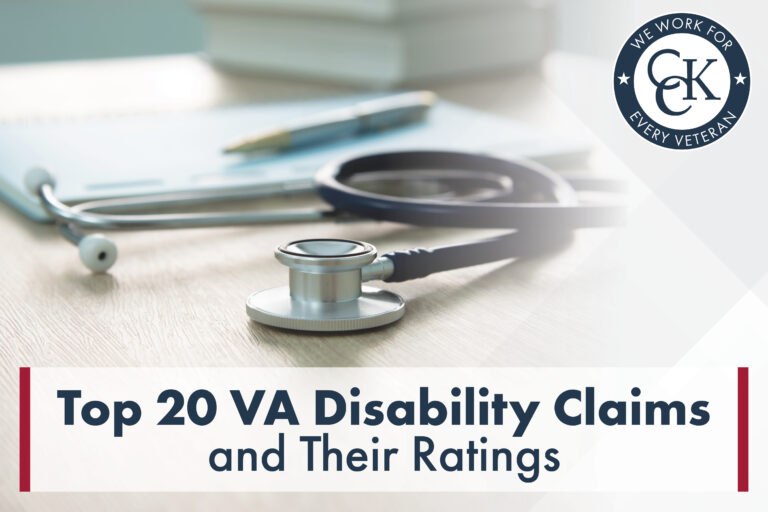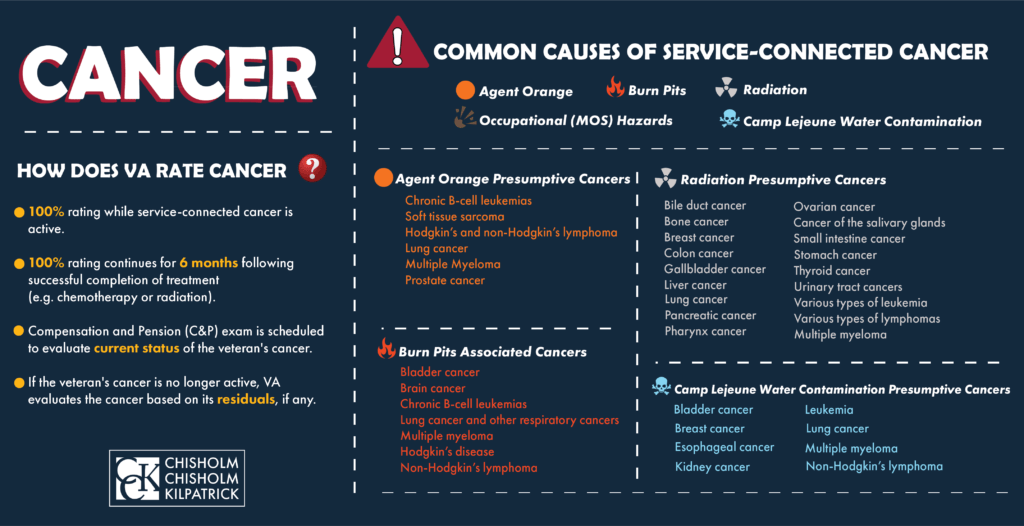Top 20 VA Disability Claims and Their Ratings

CCK Law: Our Vital Role in Veterans Law
Veterans experience certain medical conditions more than others, often at higher rates than civilians. This article will explore the top 20 VA disability claims and their ratings, based both on VA’s 2024 Annual Benefits Report and on Chisholm Chisholm & Kilpatrick’s significant experience as the nation’s largest veterans law firm.
Understanding these common conditions and how VA rates them will better prepare you for the claims process or for deciding whether to appeal.
Tinnitus
Generally, tinnitus refers to the perception of noise or ringing in the ears. This common disability is often a symptom of an underlying condition, such as hearing loss, ear injury, or a circulatory system disorder.

Common symptoms of tinnitus include phantom noises in the ears such as ringing, buzzing, roaring, clicking, hissing, and humming.
Veterans do not need a specific diagnosis of tinnitus to be granted service connection. They can provide a subjective report of their symptomatology, which is enough to show they meet the rating criteria.
VA rates tinnitus under 38 CFR § 4.87, Diagnostic Code 6260. The highest schedular rating for tinnitus is 10 percent, which takes both ears into account. It is rare that a veteran receives a higher rating on an extraschedular basis.
Hearing Loss
Hearing loss can significantly affect a veteran’s quality of life. It includes hearing muffled speech and sounds, having difficulty in understanding words (especially consonants), needing to make requests for others to speak more slowly and loudly, withdrawing from conversations, and avoiding social settings.
There are three primary types of hearing loss:
- Conductive: Affects the outer or middle ear
- Sensorineural: Involves the inner ear
- Mixed: A combination of conductive and sensorineural
Common causes include inner ear damage, earwax buildup, infections, exposure to loud noises, and ruptured eardrums. The Centers for Disease Control and Prevention notes that veterans are 30 percent more likely than non-veterans to suffer from severe hearing impairment.
VA uses two key auditory tests to diagnose hearing loss and determine disability ratings:
- Speech Discrimination Test (Maryland CNC Test)
- Pure Tone Threshold Test (Puretone Audiometric Test)
Disability ratings for hearing loss vary from 0 to 100 percent, although most veterans receive a rating between 0 and 10 percent.
Limitation of Flexion of the Knee
Limitation of flexion of the knee refers to the range of motion of the knee as the veteran moves it or curls it inward towards the body.
Generally, VA rates this condition as a musculoskeletal condition based on the range of motion that exists as the veteran moves their knee in that direction. VA looks at the range of motion in degrees rather than the pain caused by the motion.
Limitation of flexion of the knee is rated under 38 CFR § 4.71a, Diagnostic Code 5260, at 0, 10, 20, or 30 percent. The most common rating VA assigns for this condition is 10 percent.
Post-Traumatic Stress Disorder (PTSD)
Post-traumatic stress disorder (PTSD) is a mental health condition resulting from a traumatic event and characterized by a range of symptoms that vary in severity.
Common symptoms of this mental health condition include:
- Intrusive memories, flashbacks, and nightmares of the trauma
- Emotional detachment and avoidance of reminders related to the trauma
- Increased arousal, such as difficulty sleeping, concentrating, feeling on edge, and irritability
For veterans to establish a service connection for PTSD, they must provide evidence of a stressor experienced during military service that they believe led to their PTSD. This evidence can include lay statements or other documentation detailing the event.
The VA evaluates PTSD according to the Schedule of Ratings for Mental Disorders—found in 38 CFR § 4.130, Diagnostic Code 9411—and assigns disability ratings of 0, 30, 50, 70, or 100 percent. These ratings are based on the degree of social and occupational impairment, as well as the frequency, duration, and intensity of symptoms.
Lumbosacral and Cervical Strain
Veterans often suffer from back pain caused by a variety of back conditions, such as lumbosacral and cervical strains.
Veterans generally attend a Compensation and Pension (C&P) exam to measure how far they can bend forward, backward, and side to side using a goniometer. VA determines the severity of a veteran’s back condition based on the range of motion measurements provided by the examiner.
VA rates back conditions, such as lumbar and cervical strains, under 38 CFR § 4.71a, Schedule of Ratings, Musculoskeletal System, and the criteria is based largely on a veteran’s range of motion. VA can assign between a 0 to 100 percent rating.
Scars
Veterans can receive service connection for scars that result from their time in military service or from service-connected conditions that require surgery.
Scar disabilities are rated under 38 CFR §4.118, Diagnostic Codes 7800-7805. Scars are rated based on the number of scars or disfigurements a veteran has, the area of the body affected, their permanence, and the presence of pain or instability.
Scars on the head, face, or neck are rated based on skin loss and how many facial features have been disfigured. A rating for scars on areas of the body other than the head, face, or neck are generally based on the size of the scar.
A VA rating for scars can be anywhere from 0 to 80 percent, depending on the diagnostic code.
Paralysis of the Sciatic Nerve
Sciatica is a nerve condition in which pain radiates along the path of the sciatic nerve, traveling from the lower back down through the legs. It occurs when the sciatic nerve is compressed or pinched. Spinal stenosis is a common cause of sciatica.

Common symptoms of sciatica include numbness, tingling, a burning sensation, and muscle weakness.
Sciatic nerve paralysis, the most severe form of sciatica, is very common amongst veterans, primarily because it is linked to back and neck issues.
VA rates sciatica under 38 CFR § 4.124a, Schedule of Ratings, Neurological Conditions and Convulsive Disorders. Specifically, sciatic nerve paralysis is rated under Diagnostic Code 8520 at 10, 20, 40, 60, or 80 percent.
Limitation of Motion in the Ankle
Limitation of motion in the ankle usually develops following an ankle sprain that did not adequately heal or was not rehabilitated completely. Many veterans suffer from ankle injuries due to the physical demands of military training and service.
Limitation of motion in the ankle is usually rated under 38 CFR § 4.71, Schedule of Ratings, Musculoskeletal System, Diagnostic Code 5271, at 10 or 20 percent.
Migraines
Migraines are recurring, intense, or frequent headaches that may be completely debilitating. Symptoms can include pain, nausea, vomiting, sensitivity to light and sound, lightheadedness, and blurred vision.

Some factors that may contribute to the higher rate of migraines among veterans include noise exposure, intense or stressful situations, and traumatic brain injury.
VA rates migraine headaches under 38 C.F.R. 4.124a, Neurological Conditions and Convulsive Disorders, Diagnostic Code 8100. A rating for migraines can be 0, 10, 30, or 50 percent, depending on the severity and frequency of the migraines.
Limitation of Motion of the Arm
Typically, limitation of motion of the arm develops when an injury in the arm or shoulder has not healed fully or has not been rehabilitated adequately. Repeated injuries can further increase instability in the shoulder or arm and limit the range of motion.
Common causes of arm conditions include:
- Lifting heavy objects
- Forms of physical training
- Scar tissue in muscles
- A fall, impact, or accident
VA uses 38 CFR § 4.71a, Diagnostic Code 5201, to rate limitation of the arm at a 20, 30, or 40 percent. VA takes into consideration whether the veteran’s dominant or non-dominant arm is affected and how severely it is limited.
Sleep Apnea
Sleep apnea is a potentially serious disorder characterized by repeated interruptions in breathing throughout the night. It can manifest in three main forms:
- Obstructive Sleep Apnea: The most common type, where throat muscles intermittently relax and block the airway during sleep
- Central Sleep Apnea: Occurs when the brain fails to send the correct signals to the muscles controlling breathing
- Complex Sleep Apnea: A combination of both obstructive and central sleep apnea
For mild sleep apnea, doctors may recommend lifestyle adjustments, such as weight loss or quitting smoking. More severe cases might necessitate the use of a continuous positive airway pressure (CPAP) machine.
To establish a sleep apnea diagnosis for VA disability compensation, a sleep study is required. Sleep apnea is evaluated under 38 CFR § 4.97, Diagnostic Code 6847, with disability ratings of 0, 30, 50, or 100 percent, depending on the condition’s severity.
Degenerative Arthritis of the Spine
Degenerative arthritis occurs when the cartilage between joints erodes over time, resulting in joint stiffness, limited mobility, and pain. It usually occurs in weight-bearing joints, such as the back, hips, or knees.
Degenerative arthritis is rated based on the limitation of range of motion of the affected joint(s) under 38 CFR § 4.71a at 10 or 20 percent.
Traumatic Brain Injury (TBI)
Traumatic brain injury (TBI) can be caused by many factors—such as a blow to the head or an object penetrating the brain—and may result in brain dysfunction. Common causes are motor vehicle accidents and combat exposure.
Symptoms of TBI may include short-term memory loss, inability to follow directions, headaches, and personality changes.
VA rates TBIs based on the residual symptoms a veteran is currently experiencing due to the trauma under 38 CFR § 4.124a.
Rating criteria for TBI residuals are divided into 10 subcategories to evaluate the condition based on the level of severity and impairment in each area. Ratings range from 0 to 100 percent.
Depression
Depression is a serious mental health condition that affects the way a person thinks, feels, and acts. Symptoms of depression, as with other mental health conditions, may include feelings of sadness, worthlessness, and hopelessness; lack of motivation or interest; sleep and concentration issues; change in appetite; irritability; and fatigue.
Depression is rated under 38 CFR § 4.130, the General Rating Formula for Mental Health Disorders, at 0, 10, 30, 50, 70, or 100 percent depending on the level of social and occupational impairment.
Respiratory Conditions
Respiratory conditions—asthma, chronic obstructive pulmonary disease, respiratory cancers, and more—are common among veterans due to in-service exposure to burn pits, Agent Orange, and other airborne hazards.
VA presumptive service connection (i.e., Agent Orange presumptions or the new particulate matter presumption) does exist for some respiratory conditions if the veteran meets certain qualifying criteria.
VA rates respiratory conditions under 38 CFR § 4.97. The range of possible ratings depends on the specific condition and the diagnostic code used.
Asthma, for example, is rated under Diagnostic Code 6602 from 0 to 100 percent. Allergic rhinitis is rated under Diagnostic Code 6522 at 10 or 30 percent.
Diabetes Mellitus Type 2
Type 2 diabetes is a chronic condition that causes a person to experience increased blood glucose levels due to insulin resistance or deficiency.
Diabetes mellitus type 2 is included in VA’s list of presumptive conditions associated with exposure to Agent Orange or other herbicides.
Type 2 diabetes is rated under 38 CFR § 4.119, Diagnostic Code 7913, at 10, 20, 40, 60, or 100 percent.
Cancer
Veterans may develop various types of cancer due to their service, including but not limited to lung, prostate, and brain cancer, as well as leukemias. One primary cause of cancer in veterans is toxic exposure. Specifically, those who served during the Vietnam War may be eligible for a presumptive service connection for cancers caused by Agent Orange exposure, as outlined by VA under 38 CFR § 3.309, which includes:
- Chronic B-cell leukemia
- Soft-tissue sarcoma
- Hodgkin’s and non-Hodgkin’s lymphoma
- Multiple myeloma
- Prostate cancer
- Leukemia
- Lung cancer
- Multiple myeloma
If a veteran’s cancer is service-connected, VA generally assigns a 100 percent disability rating for as long as the cancer remains active, plus six months post-treatment (e.g., chemotherapy, radiation, surgery). After this period, a C&P exam is conducted to evaluate the cancer’s status. If the cancer is in remission, VA evaluates its residuals and grants a disability rating accordingly. A disability rating for cancer ranges from 0 to 100 percent for residuals.

Pes Planus (Flat Feet)
Pes planus, or flat feet, is a common foot deformity in which the arch of the foot is flattened to the point where it touches, or nearly touches, the ground.
Most of the time, those with flat feet do not experience serious symptoms and treatment may not be necessary. However, those with more severe cases may experience symptoms such as:
- Feet tiring out easily
- Aches or pains in the areas of the arches or heels
- Foot swelling
- Difficulty performing certain foot movements, such as standing on your toes
- Leg and back pain
VA rates veterans with flat feet under 38 CFR § 4.71a, Diagnostic Code 5276 at 0, 10, 20 30, or 50 percent.
Anxiety
Anxiety is defined as intense, excessive, and persistent worry and fear about everyday situations. Symptoms can include restlessness, trouble concentrating, muscle tension, difficulty sleeping, and more.
VA uses the General Rating Formula for Mental Health Disorders under 38 CFR § 4.130 to assign a 0, 10, 30, 50, 70, or 100 percent rating based on social and occupational impairment.
Secondary Conditions for Service Connection
Finally, many veterans are service-connected on a secondary basis, which means that their disability stemmed from an already service-connected condition.

Some common secondary conditions are:
- Radiculopathy secondary to back pain
- Peripheral neuropathy secondary to diabetes mellitus type 2
- Hypertension secondary to PTSD
- Depression secondary to Parkinson’s disease or cancer
Were Your VA Benefits Denied?
If you filed a claim for a service-related disability but VA denied you disability compensation, Chisholm Chisholm & Kilpatrick LTD may be able to help. Our experienced veterans advocates have helped many veterans secure rightfully earned benefits for their service-related injuries. As the country’s largest veterans law firm:
- Our deep resources mean excellent client service. We can attract top talent, maintain consistent communication, and purchase great tools.
- We have highly skilled lawyers, as seen by our unique experience in court, the number of precedential cases that we have argued, and the one billion dollars we have obtained on behalf of clients in situations like yours.
- We know how to go head-to-head with VA. Our unparalleled experience gives us insights, systems access, and connections.
Reach out to CCK today to schedule a free case evaluation with a member of our team.
About the Author
Share this Post
